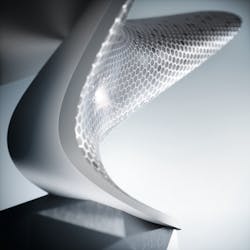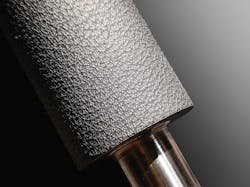JON CARLSON
Manufacturing engineers and industrial designers continually seek ways to improve their products and outpace competition. One path to enhanced product design involves manipulation of increasingly precise surface textures that can affect both product performance and aesthetics. These high-value textures range from inventive and functional patterns in molds for plastic bottles or automotive interior features to scientifically developed medical implant surface features intended to accelerate the body’s acceptance of a replacement joint.
Traditionally, manufacturers have produced part surface textures via methods such as grit blasting, chemical etching, or a combination of the two. These long-established methods have been effective, but require high amounts of time and intensive labor and are subject to human error. They lack predictability, repeatability, and the capability to create extremely fine dimensional tolerances and complex surfaces. Both processes also generate ecologically problematic byproducts.
With the advent of laser texturing, however, product designers are developing precise and intricate textures via five-axis laser texturing driven by computerized imaging and computer numerical control (CNC) technology. Laser texturing facilitates production of complex patterns and other features on mold cavities, end products, and a wide range of other items while saving time and production costs, and eliminating environmental issues.
Laser texturing benefits
Textured surfaces serve both functional and aesthetic purposes. For example, grained textures and contoured shapes in automotive interiors and exterior components convey an image and feel of high quality and value at minimal additional cost in materials.
In the past, automakers created textured features in interior components using laser-textured foils that were wrapped on to master models for part-forming tooling. The process was expensive, time-consuming, and prone to errors. When making molds for parts, chemical etching usually involves disassembling a mold to its cavity and core, and then reassembling it after etching. Aside from the etching process itself, the disassembly and reassembly of the mold consumed excessive time. Now, textures generated with 3D CNC laser guidance provide designers with a greatly expanded range of pattern choices and precision, some of which were not possible with prior texturing technologies.
The laser technology’s speed and convenience enables fast response to changing demands for customization and personalization. Molds for automotive components as large as door panels, bumpers, and even entire interiors can be directly laser-textured quickly and accurately.Another automotive design application involves textures and details on headlight lenses that are becoming more complex and precise amidst efforts to maximize headlight focus and reach. Laser texturing technology allows complete control of lens mold features. It also provides distinct demarcation between textured and unaffected areas, something that can be difficult or impossible to achieve when using chemical etching methods.
When automobile parts are globally sourced and produced, complicated and labor-intensive processes such as chemical etching often do not translate well across countries and continents. Because the digital commands guiding CNC laser texturing programs are the same worldwide, laser texturing can reliably produce the same part features at multiple suppliers.
Medical equipment design also benefits from advances in the generation of precision laser textures. For implantable devices such as artificial hips and dental implants, clinical research has determined that adding texture improves integration of the implant with the patient bone material, makes the joint more stable, and promotes growth of supportive tissue.
Often times, implants have been textured via abrasive blasting and chemical etching. The accuracy and repeatability of the process are sensitive to time and temperature, and traditional texturing methods also produce chemical and metal wastes. After texturing, removal of blasting and etching residue is critical and may require multiple part washings as well as special cleaning equipment such as ultrasonic wave technology. Inadvertent contamination from improper chemical mixes or insufficient cleaning can result in product recalls at best, and at worst failure of the component by rejection after it is implanted in the patient.
Because laser texturing is a digital process, it offers the unfailing accuracy and repeatability required in medical implant manufacturing. It enables product designers to fine-tune the surfaces of implants in response to research findings on the effects of different textures on implantation results.
Current laser texturing technology such as the GF Machining Solutions LASER S five-axis laser texturing systems represent fully digitized manufacturing processes for generating detailed and nuanced texturing, microstructuring, and marking. The technology is faster, more accurate, and more repeatable than mechanical and chemical processes, in addition to being environmentally friendly. Multiple textures can be applied on the same component, with no need for the masking that is required in multiple applications of chemical etching.
System features
The LASER S five-axis system uses high-quality digital images and CAD data, allowing for completely reproducible results in both large and small job lot sizes. This system features an optical focus point shifter—a high-speed 3D scanning system—that enables the machine to follow the surface of the part and maintain consistent metal removal performance.
The system’s dedicated workstation software enables in-depth job preparation control, including UV mapping for applying textures and 3D simulation. The digital images can be bitmap/grayscale files created in Photoshop, or IGES or STEP files derived from a natural surface via reverse engineering with a 3D scanner. Versions of the machines can handle workpieces up to 4 × 3 m in size.
After the machine’s workstation software merges a virtual workpiece with a virtual texture, a shop can preview the final design results. Programming of laser texturing operation basically requires only the same programming skills as would be needed to machine a simple component on a conventional CNC machine tool.
The key to the laser-texturing operation is positioning the laser’s focal point at the correct distance from the workpiece surface. The material ablation rate is based on the frequency and power setting of the laser. Power settings can be adjusted anywhere from 0% to 100%, and frequency from a level of 10 to 90, to determine how fast the laser will ablate/cut material.
The machines use a 50 W ytterbium pulsed fiber laser to render the desired patterns or textures. The fiber lasers are extremely precise and can remove microns of material at a time. The machines can make very light and shallow cuts or no cut at all, sometimes using the laser to only change the color of a part’s surface for strictly aesthetic reasons if desired.
Programmable, tilting laser heads are standard on the machines, as are high-resolution cameras with integrated illumination for fine positioning, integrated touch probes, dust exhausts, central lubrication systems, and lenses of varying focal strengths. Laser texturing produces no fluids, slurry, or chips, and dust particles produced by the process are automatically extracted via a vacuum.
The choice of laser texturing technology (laser pulse duration, power, texturing pattern) is driven by the surface the manufacturer wants to produce. While these machines employ nanosecond lasers, the company also offers machines that use nanosecond, femtosecond, or a combination of both of those laser pulse technologies. Nanopulse duration lasers will both ionize metal and locally heat the surface being treated, while the short pulse duration of femtosecond lasers prevents materials from entering a fusion state during texturing, making them ideal for use on heat-sensitive parts.
For production-level part volumes, the machines can be integrated with GF AgieCharmilles pallet changing systems and modular pallets from System 3R (Stockholm, Sweden).
Growing familiarity with the benefits of laser texturing technology is seeing its use expand to an increasing number of applications across the manufacturing industry. CNC-guided laser texturing provides multiple benefits to part designers, manufacturers, and end users of a wide range of products. Designers gain flexibility in the variety and precision of the surface textures they can specify. No allowance is necessary to compensate for variations in the final texture that might result from inconsistencies in blast/etch methods. Manufacturers can use a stable, consistent process that produces minimal, if any, rejected parts, and inspection requirements are greatly reduced. End users enjoy final products that precisely and repeatedly meet their specific needs.
JON CARLSON ([email protected]) is Product Manager – Advanced Manufacturing at GF Machining Solutions LLC, Lincolnshire, IL; www.gfms.com/us.

